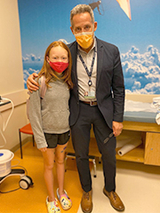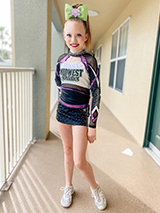Papillary Thyroid Cancer Second Opinion: Rowan’s Story
Papillary Thyroid Cancer Second Opinion: Rowan’s Story
Thyroid cancer is uncommon in children, so when at age 5 Rowan began having difficulty swallowing and developed a cough that lasted for months, none of the various providers she saw over several years in her home state of Ohio thought “cancer.” After a thyroid cancer diagnosis was made when she was 9, her family sought a second opinion at Children's Hospital of Philadelphia (CHOP). The first time Rowan’s mother, Kristina, spoke on the phone with Lindsay Sisko, BSN, the nurse coordinator in CHOP’s Pediatric Thyroid Center, “I felt like the weight of the world had lifted.”

The cough that Rowan couldn’t shake at age 5 led the family to an allergy and asthma clinic at a nearby children’s hospital, where she failed a lung function test. Asthma seemed to be the culprit. For several years, she continued to have difficulty swallowing. Finally, during a sick visit, their pediatrician noticed a lump in the right side of her neck — but typically, a lump that indicates thyroid cancer is located in the front of the neck. When the lump was still there after a few weeks, the doctor sent them to an ear/nose/throat specialist, whose first reaction was, “This doesn’t feel like cancer.” But a biopsy proved that it was. A CT scan showed that the cancer had spread not only to lymph nodes in her neck also to her lungs.
Papillary thyroid cancer in children is more likely to spread to the lymph nodes and the lungs than in adults. But even when that happens, pediatric patients have more than a 95% survival rate 20 to 30 years after treatment. Unfortunately, despite high survival rates, complications from surgery and medical therapy are possible and are related to the experience level of the institution where a patient receives care.
Despite positive survival rate statistics like these, any pediatric cancer diagnosis is traumatic for caregivers and the child. In Rowan’s case, however, it was a particularly difficult twist of fate. For reasons her family can’t exactly explain, Rowan had developed a deep fear of dying from cancer and was in behavioral health therapy to help manage her fears. When her parents accompanied her to a therapy session and told her she had cancer, “She lost it. We all did,” says Kristina.
The cancer gets a nickname
Quickly enough, though, Rowan found resilience and discovered creative ways to cope. “She made up names for everything,” explains Kristina. The cancer that was getting surgically removed got named “Rocky,” and Rocky and his family (the lymph nodes in her neck) needed to come out. Her thyroid, which was also removed, was named “Priscilla.” After surgery, Rowan received radioactive iodine therapy in an effort to destroy any remaining thyroid cancer cells in her neck as well as the cells that had invaded her lungs. The radioiodine therapy was named “Pac Man” because it chomped up all the bad stuff (the cancer).

Rowan’s two surgeries were performed by her team in Ohio, but when considering the next treatment steps, her family decided to seek out a second opinion. “I was part of a support group for parents of children with thyroid cancer, and everyone kept mentioning CHOP, saying, ‘Go there!’” says Kristina. After the positive experience of the initial phone call, the family traveled to CHOP. Rowan was seen by pediatric endocrinologist Andrew Bauer, MD, Medical Director of the Pediatric Thyroid Center. The family appreciated how thorough and kind everyone was: “I felt that this is where we’re supposed to be,” says Kristina.
Rowan subsequently received radioactive iodine therapy in an effort to eliminate any cancerous thyroid cells remaining in her neck and her lungs. Thyroid cells are unique in that, unlike other cells in the body, they are able to absorb iodine, which is highly toxic to the cells and destroys them. After this initial treatment, she got scans every few months, which showed that the cancer in her neck was gone, but the cancer nodules in her lungs were growing. Genetic testing of her tumor identified a common cancer-driving alteration, a NTRK-fusion, a gene that can be targeted with a specific medication that inhibits growth and causes the tumor to shrink. After several discussions, Rowan’s mom agreed to start the medication, and Dr. Bauer referred Rowan to the CHOP Advanced Pediatric Thyroid Cancer Therapeutics Clinic, a program co-directed by Dr. Bauer and pediatric oncologist Theodore Laetsch, MD, who also leads both the Developmental Therapeutics Program and the Very Rare Malignant Tumors Program.
Precision medicine shrinks the cancer in her lungs
Two months later, in October 2021, the family was back at CHOP for a visit. “Dr. Laetsch was so sweet. He showed us her scans from July, and pointed out the cancer spots,” Kristina recalls. “Then he showed us the scans taken that day, and asked Rowan if she could find any spots — because he couldn’t!” For the first time, the nodules had shrunk. “My heart exploded with relief,” says Kristina. “There were still some there, but they were no longer growing.”

Rowan will continue taking the NTRK-inhibitory medicine for the near future, and then her care team and family will consider the next steps. Another round of radioactive iodine therapy may be an option, as early evidence suggests that in some patients, medications that block the genetic mutations that caused the cancer can increase the effectiveness of radioactive iodine therapy.
Rowan’s passion right now is her competitive cheer team. She’s at the gym four days a week and takes private lessons to improve her tumbling. Although a year ago she wasn’t confident in her skills and several times considered quitting, the team went to a national competition and won. “Now she never talks about quitting, and she cartwheels everywhere she goes,” Kristina says with a laugh.
“Traveling to Philadelphia for a second opinion was the best decision we made in Rowan’s thyroid cancer journey,” says Kristina. “We love Dr. Bauer. He is always so patient and thorough with us, and always answers the zillion questions I have. And Dr. Laetsch is amazing.” Although CHOP is an eight-hour drive away, “It’s our home team.”